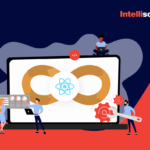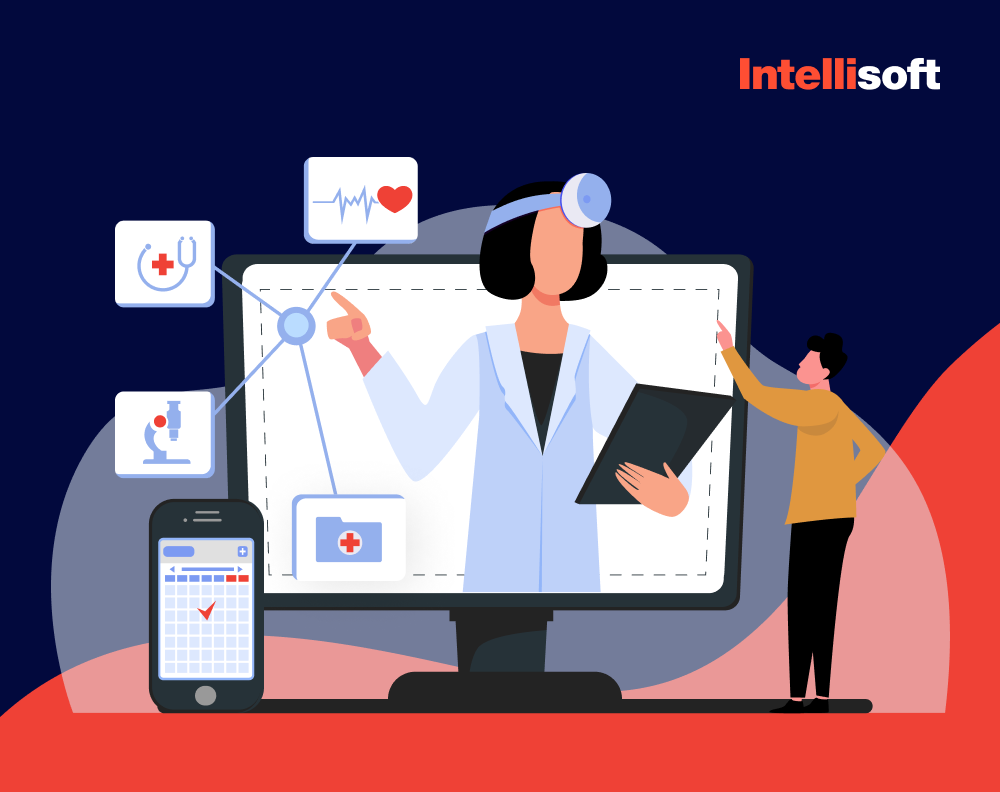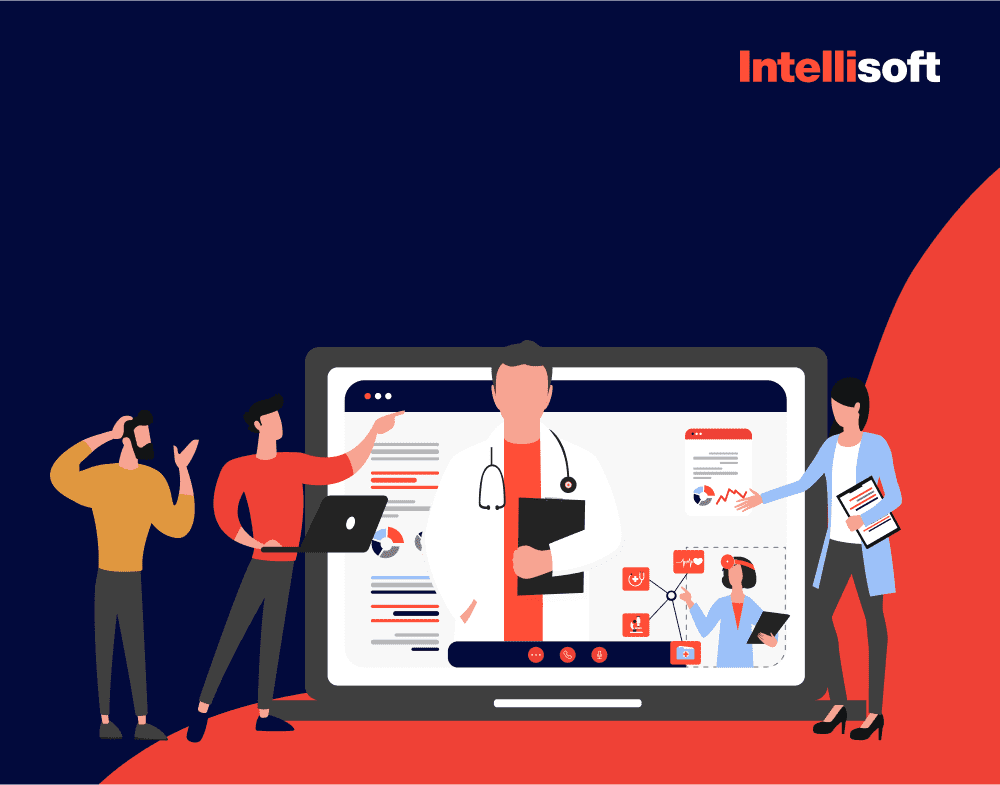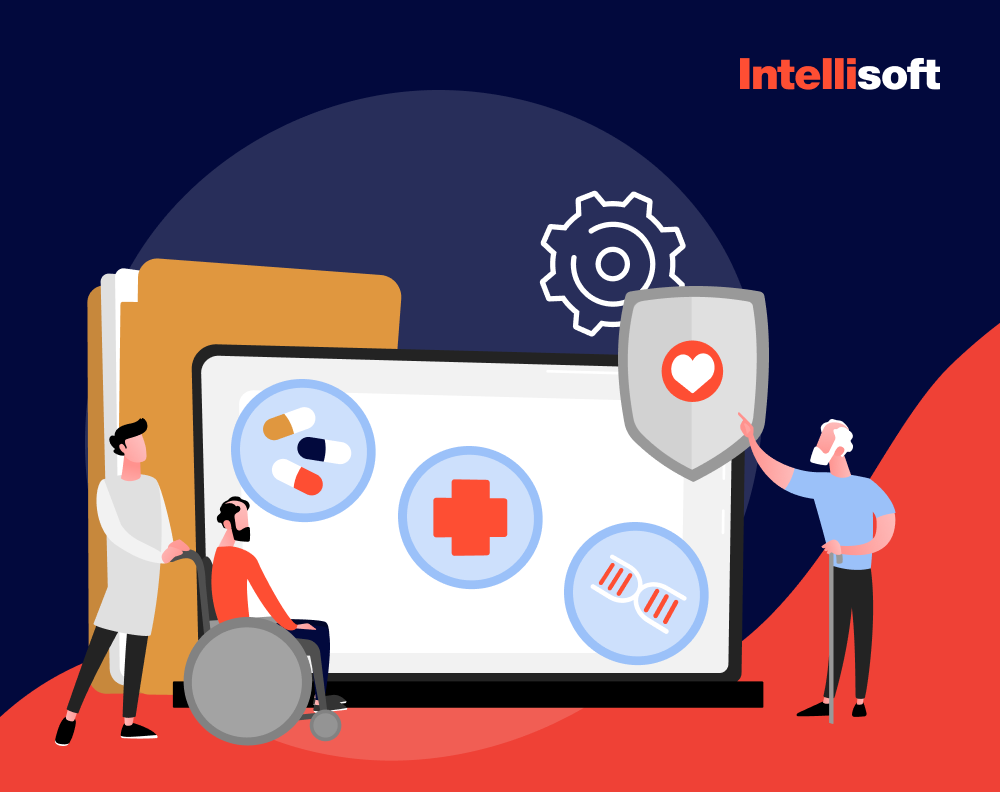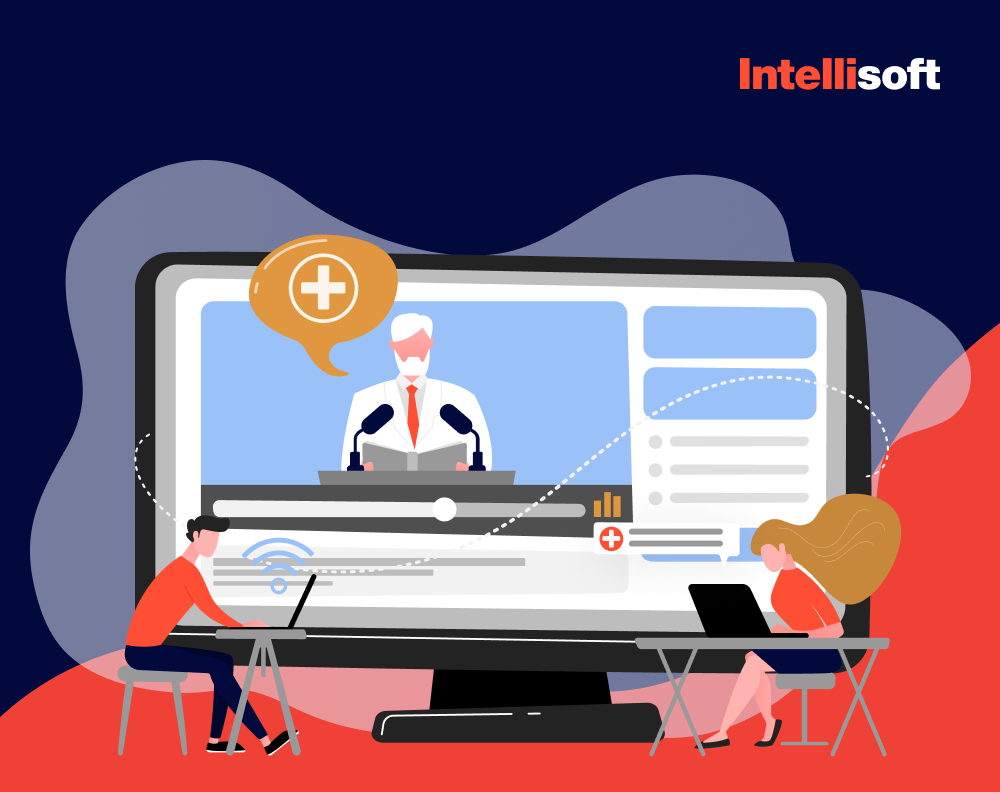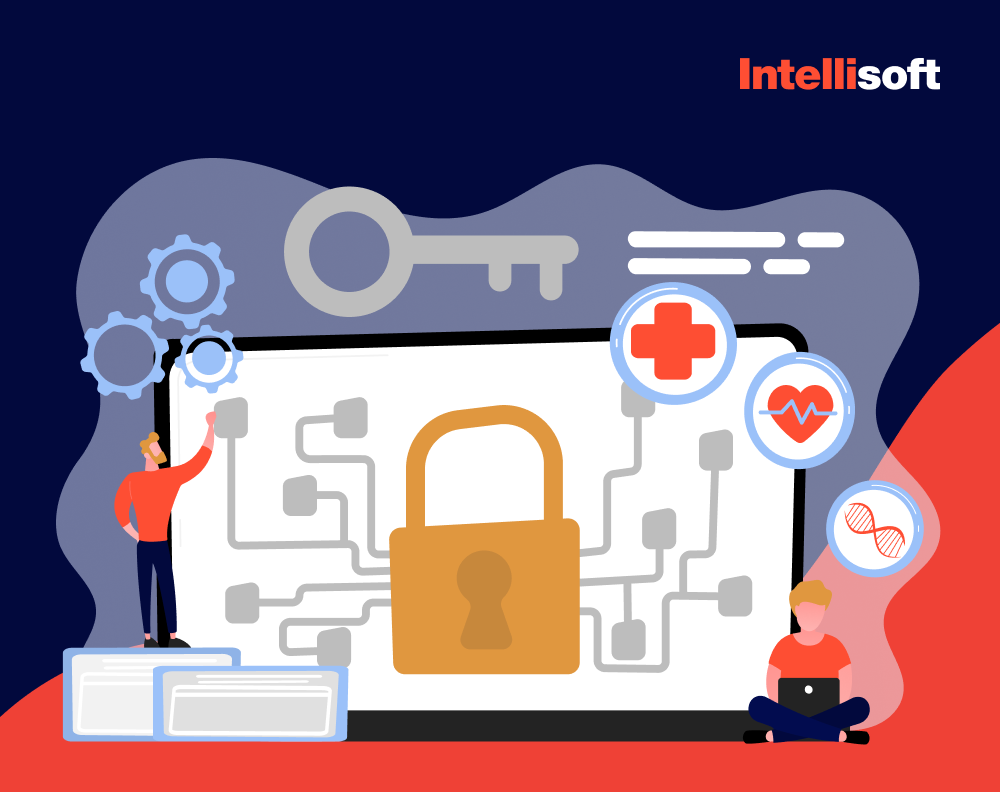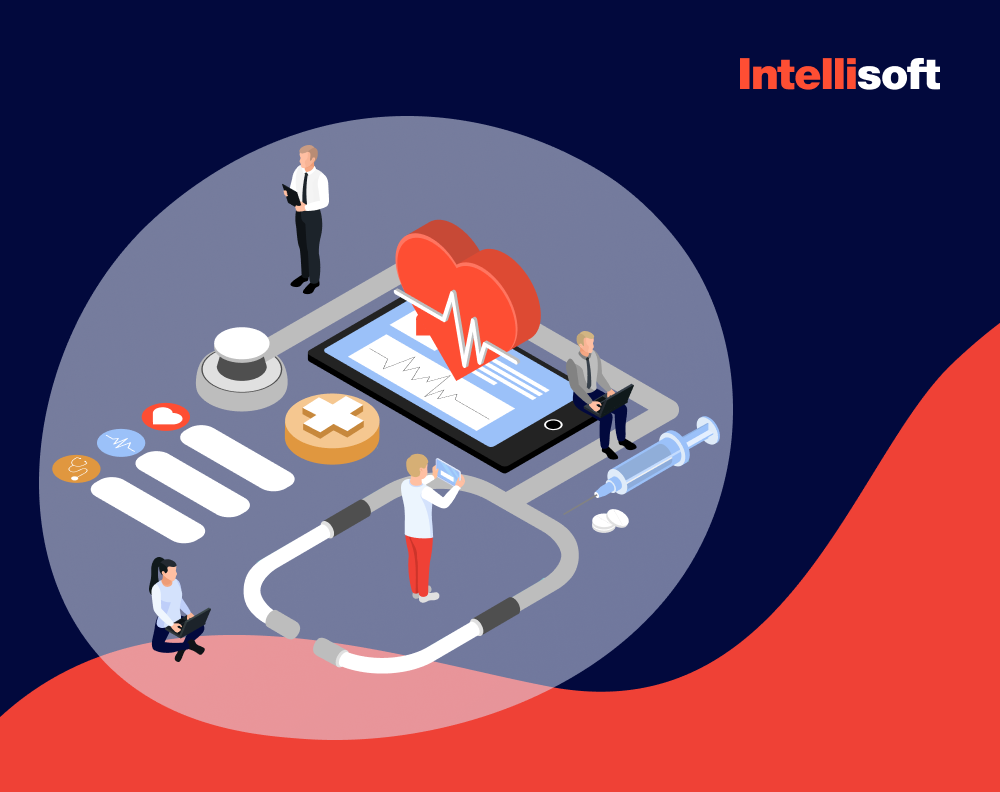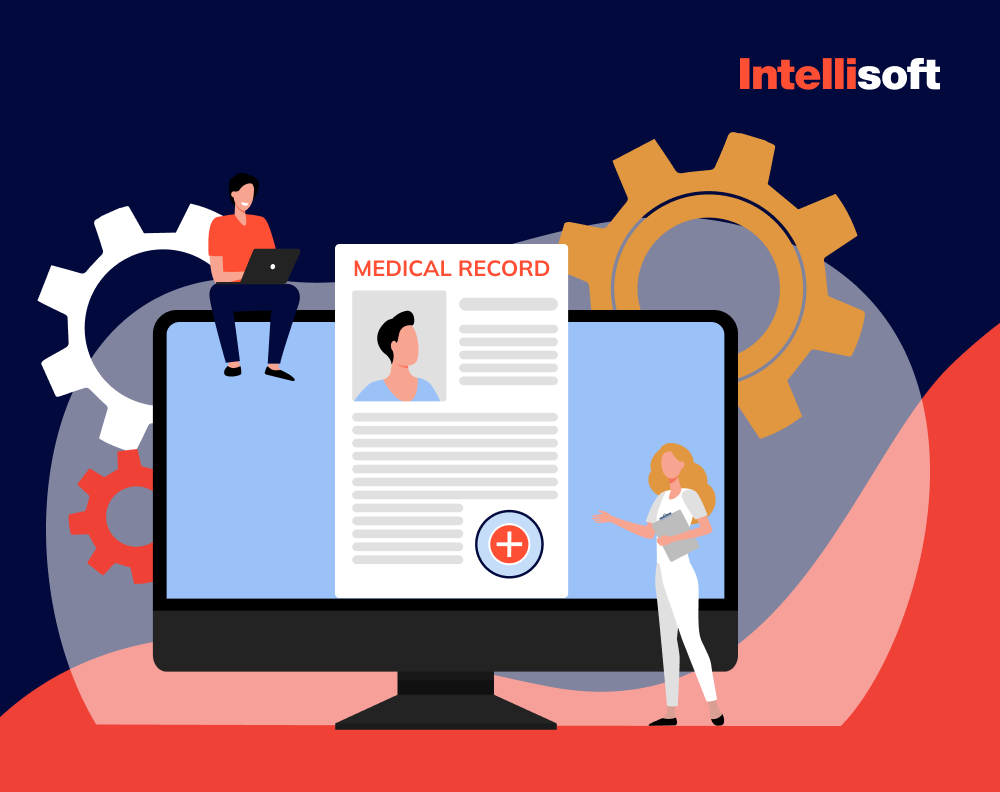Modern healthcare has become increasingly efficient thanks to better accessibility, instant support, and streamlined administrative tasks. This transformation is possible thanks to AI chatbots in healthcare. These virtual assistants, powered by advanced artificial intelligence, are changing how we interact with healthcare systems. They ensure services are available around the clock and more responsive than ever.
At IntelliSoft, we have been leading this innovation. With over a decade of experience in healthcare software development, we have seen the impressive evolution of chatbots. They have advanced from simple automated responders to sophisticated AI-driven agents. Today, they can assess symptoms, provide consultations, renew prescriptions, and schedule appointments. The growth potential is enormous. The US market alone for AI chatbots in healthcare is expected to reach $394 million by 2032. This growth highlights their effectiveness and the industry’s confidence in their future.
Why is this important? Integrating AI chatbots is not just about embracing new technology. It is about setting a new standard in patient care. Enhanced efficiency, reduced workload for medical professionals, and improved patient outcomes are now achievable. Keep on reading to discover why building a healthcare chatbot should be your next strategic move.
Table of Contents
Healthcare Chatbot Market Statistics: A Rising Tide
The healthcare industry is experiencing significant changes driven by the rise and integration of chatbot technology. In 2022, the medical chatbots market was valued at USD 0.2 billion. Experts anticipate a substantial increase, with the market expected to grow to USD 0.99 billion by 2032. This projection represents an impressive compound annual growth rate (CAGR) of 19.5% from 2023 through 2032, indicating strong expansion within the sector.
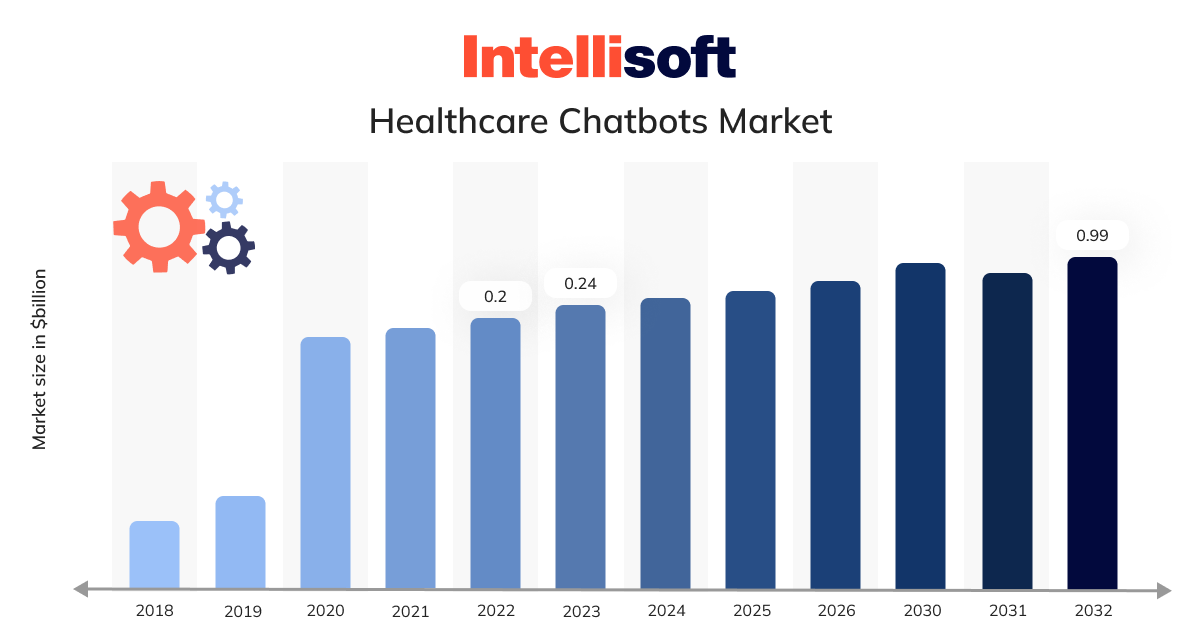
Regionally, North America has established itself as a leader, contributing over 60% of the market’s revenue share in 2022. This regional dominance is also reflected in deployment methods. Cloud-based models, which accounted for about 75% of the market, have shown their scalability and efficiency. This segment is leading and the fastest-growing, highlighting a move towards more flexible and accessible medical solutions.
On the component level, software remains the primary demand driver for healthcare chatbots worldwide. This trend underscores the technology’s broad adoption across various healthcare applications. Symptom check applications have achieved the highest market share, emphasizing their vital role in initial healthcare assessments.
The end-user landscape reveals that patients increasingly rely on chatbots for various healthcare interactions. This shift illustrates the significant market share held by the patient segment, fueled by the ongoing trend of consumerizing healthcare. This movement aims to make medical services more patient-centered and accessible through technology.
As the market continues to grow, the potential of medical chatbots becomes even clearer. Whether exploring their current utility or future opportunities, the expanding field of healthcare chatbots represents a new frontier of innovation in patient care.
Transformative Benefits of Chatbots in Healthcare
The integration of chatbots in the healthcare sector brings transformative benefits. These advancements enhance both patient care and operational efficiency. As chatbot technology evolves, it becomes a vital tool for modern medical systems. This transformation is driven by their ability to streamline interactions and personalize patient support.
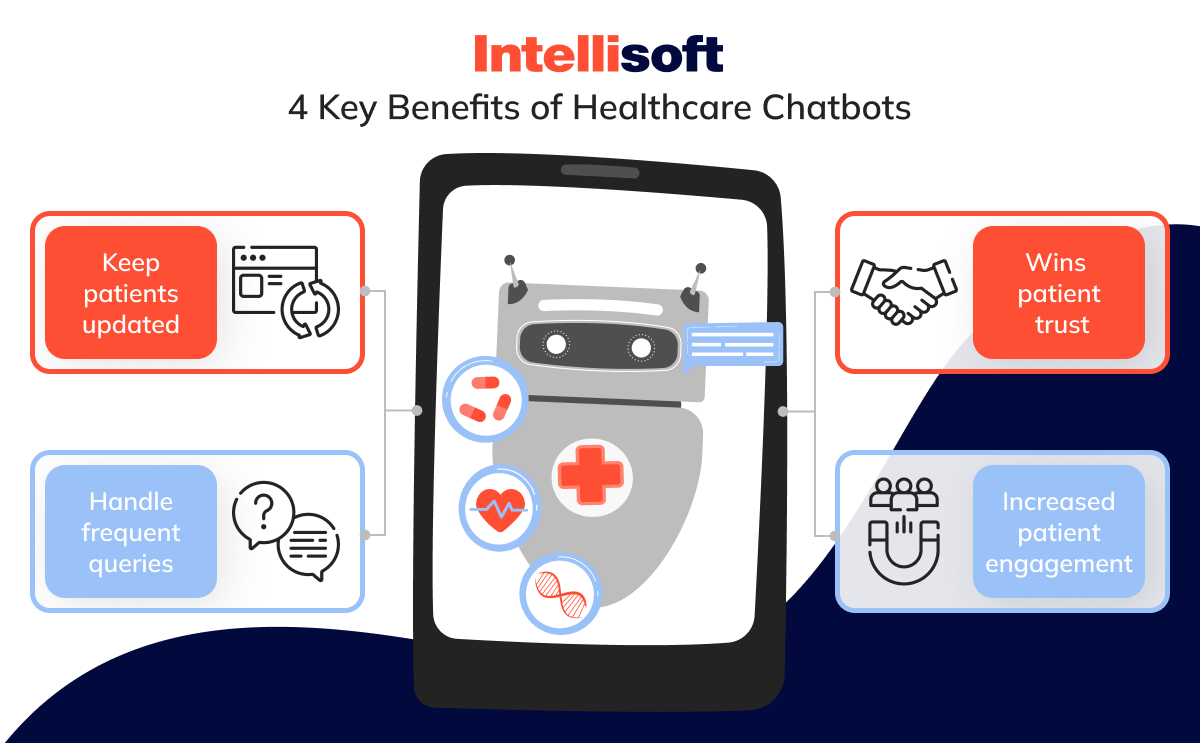
Prompt Communication and Timely Reminders
Healthcare chatbots excel in providing timely updates and reminders, which are critical in patient care. They automate the sending of appointment reminders and medication refill alerts. They also deliver educational content tailored to specific health conditions. This consistent engagement helps reduce missed appointments and medication non-adherence, significantly improving patient health outcomes.
Building Trust Through Transparency
Transparency is key to effective healthcare, and chatbots contribute significantly. By clearly outlining their capabilities and limitations, medical organizations can build trust with patients. Additionally, chatbots enhance this trust by delivering reliable, up-to-date information from credible medical databases. This ensures patients receive trustworthy data on their health inquiries.
Streamlined Query Management
Chatbots efficiently handle a high volume of patient inquiries, managing routine questions and concerns that do not need direct medical intervention. This capability allows medical professionals to focus more on complex cases and direct patient care rather than administrative tasks. As a result, response times are quicker, and patient wait times are reduced, leading to a more satisfying and positive patient experience.
Enhanced Patient Engagement
With their 24/7 availability, chatbots enable continuous patient engagement. This allows individuals to access medical support anytime, which is particularly beneficial in a world where immediate access to information and support is often expected. Chatbots can perform various functions, from answering basic health questions to scheduling appointments, all through an intuitive digital interface. This accessibility appeals especially to those who favor a self-service approach to healthcare, enhancing their involvement and satisfaction with the healthcare services provided.
The benefits of chatbots in healthcare are clear. They support the operational aspects of healthcare provision and enhance the patient experience. Chatbots are revolutionizing patient care by ensuring that engagements are more personalized, timely, and efficient.
Related readings:
- Main Benefits of AI in Healthcare: How AI Brings New Solutions to the Industry
- Automation in the Industry of Healthcare: Main Benefits for Business
- Predictive Analytics in Healthcare: How To Implement In Your Organization
- App for Doctor Appointment Development: A Comprehensive Guide
- Healthcare App Development Guide: Transforming Patient Care with User-Centric Solutions
Different Types of Chatbots in Healthcare and Their Impact on the Industry
Chatbots in healthcare industry settings are rapidly evolving. Each is designed with specific functions to meet various needs within the medical system. So, how are chatbots used in healthcare? These AI-powered assistants enhance patient care, improve operational efficiency, and provide critical support across different areas of healthcare.
Informational Chatbots: Your Digital Health Guide
Informational chatbots act as on-demand health educators and guides. They offer patients instant access to health-related information. These chatbots address common inquiries about hospital services, explain medical procedures simply, and provide educational content tailored to individual patient needs. These chatbots enhance patient education by guiding patients to the right resources and clarifying health-related questions. They also reduce the workload on medical staff, ensuring inquiries are resolved efficiently.
Diagnostic Chatbots: Preliminary Medical Assessment Tools
Diagnostic chatbots are transforming initial medical consultations. They use AI to analyze symptoms and suggest possible diagnoses. These chatbots interactively collect patient data, including symptoms and medical history, to provide informed suggestions about potential health issues. They reduce unnecessary hospital visits by advising on self-care and when to seek professional help. This approach helps patients manage minor health issues from home, streamlining the pathway to appropriate medical care.
Therapy and Mental Health Chatbots: Accessible Emotional Support
Therapy and mental health chatbots offer crucial support. They facilitate mental health therapies such as cognitive-behavioral therapy (CBT) and mindfulness practices. These chatbots provide a discreet and immediate source of help, extending support beyond traditional therapy sessions. They play a significant role in destigmatizing mental health care and making therapeutic resources accessible to a broader audience. This tool is especially valuable for individuals hesitant about traditional therapy avenues.
Administrative Chatbots: Streamlining Healthcare Operations
Administrative chatbots are designed to optimize routine administrative tasks within healthcare settings. They handle everything from scheduling appointments to processing insurance claims and managing prescriptions. These chatbots enhance operational efficiencies across medical facilities. They improve patient satisfaction by offering convenient scheduling and payment solutions. Additionally, they support healthcare providers by automating administrative duties, allowing them to focus more on patient care.
Each type of chatbot serves a distinct purpose. They contribute to a more integrated, efficient, and patient-centered healthcare system. As technology advances, the role of chatbots will become even more central in shaping modern healthcare delivery. The future of chatbots in healthcare will make services more accessible and tailored to individual patient needs.
Pioneering Examples of Chatbots in Healthcare
The use of chatbots in healthcare is transforming patient interactions and improving service delivery worldwide. Here are some notable examples of medical organizations and entities effectively using chatbots to facilitate medical care and customer engagement.
OneRemission: Empowering Cancer Patients
Based in New York, OneRemission has developed a chatbot to support individuals battling cancer. This chatbot provides users comprehensive information on diets, exercises, and post-cancer practices recommended by Integrative Medicine experts. The goal is to empower patients and survivors with self-help tools, reducing their dependency on direct medical consultations. Additionally, the chatbot offers the convenience of online consultations with an oncologist, enhancing the support system for cancer fighters and survivors.
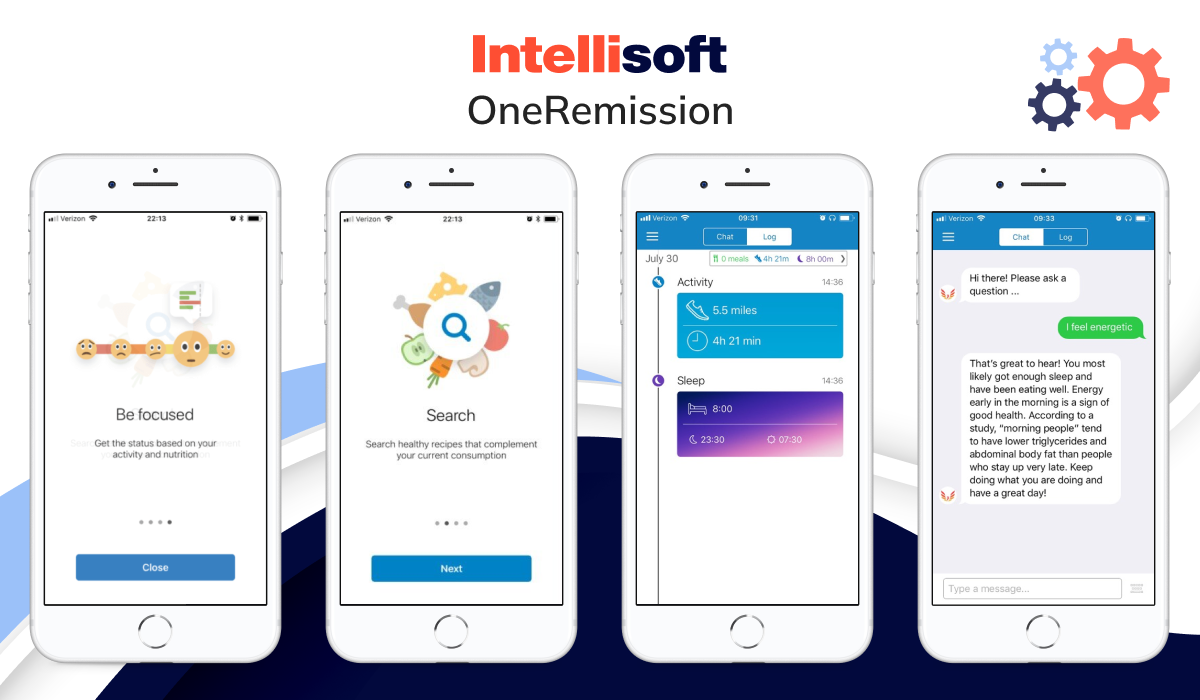
WHO: Spreading Vital Health Information Globally
During the COVID-19 pandemic, the World Health Organization (WHO) utilized a chatbot via WhatsApp to distribute essential information about the virus. This information included details on symptoms, prevention, and treatments. The chatbot reached approximately 13.5 million people in 19 different languages, demonstrating the effectiveness and scalability of chatbots in managing public health communications during a global health crisis.
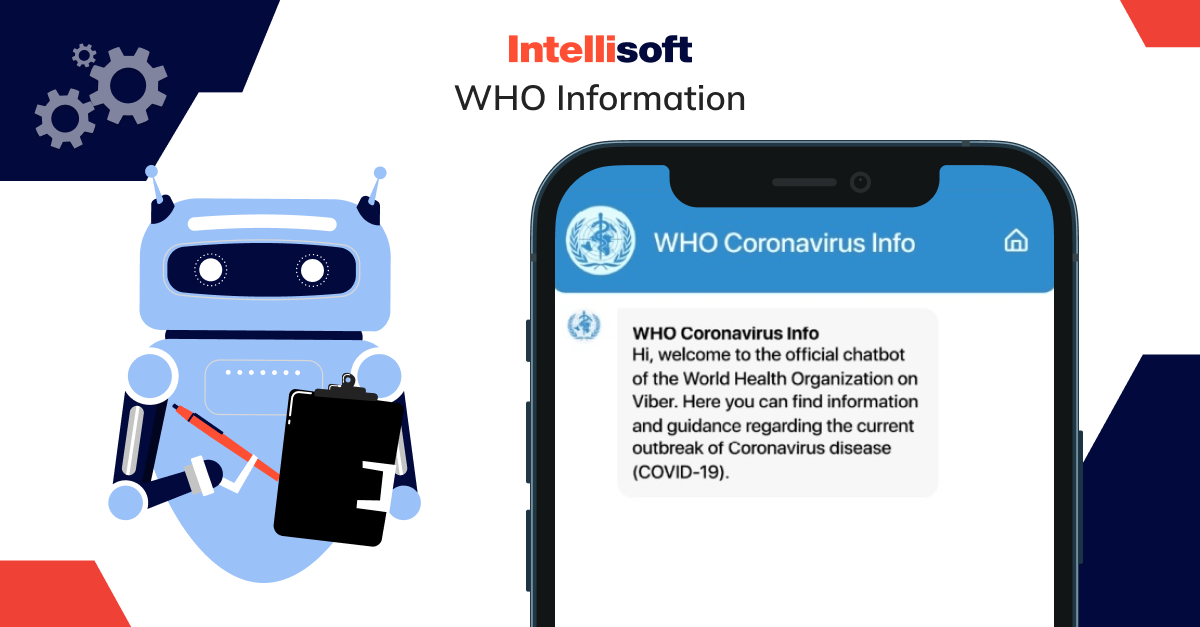
Pfizer: Revolutionizing Patient Engagement
Pfizer has adopted AI chatbots to transform its customer interactions. Across various regions, Pfizer’s chatbots, such as Medibot in the US, Fabi in Brazil, and Maibo in Japan, provide accessible, non-technical medical information. These chatbots reduce the demand on human call centers and streamline the flow of information, making medical knowledge more accessible to the public and enhancing patient care.
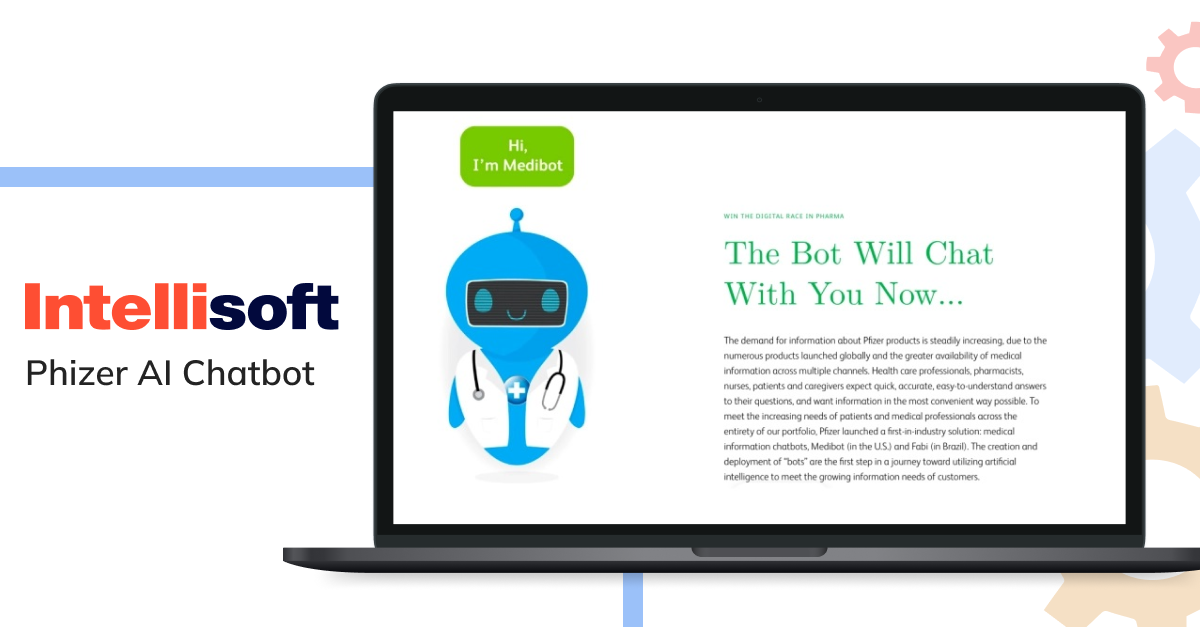
Zydus Hospitals: Streamlining Appointments and Operations
Zydus Hospitals, one of India’s leading multispecialty hospital chains, has integrated multilingual chatbots to facilitate appointment scheduling. This innovative approach has made medical consultations more accessible and significantly boosted the hospital’s operational efficiency and revenue. The chatbots provide a seamless user experience, offering appointment reminders and preparation guidelines, improving service reliability and patient satisfaction.

Saba Clinics: Enhancing Patient Feedback Mechanisms
Saba Clinics, a prominent skincare and wellness center in Saudi Arabia, has leveraged a WhatsApp chatbot to revolutionize patient feedback collection. This proactive approach allows the clinic to collect valuable insights into patient experiences through preferred communication channels, leading to high engagement and response rates. The feedback collected via the chatbot is instrumental in refining services and enhancing patient care quality.
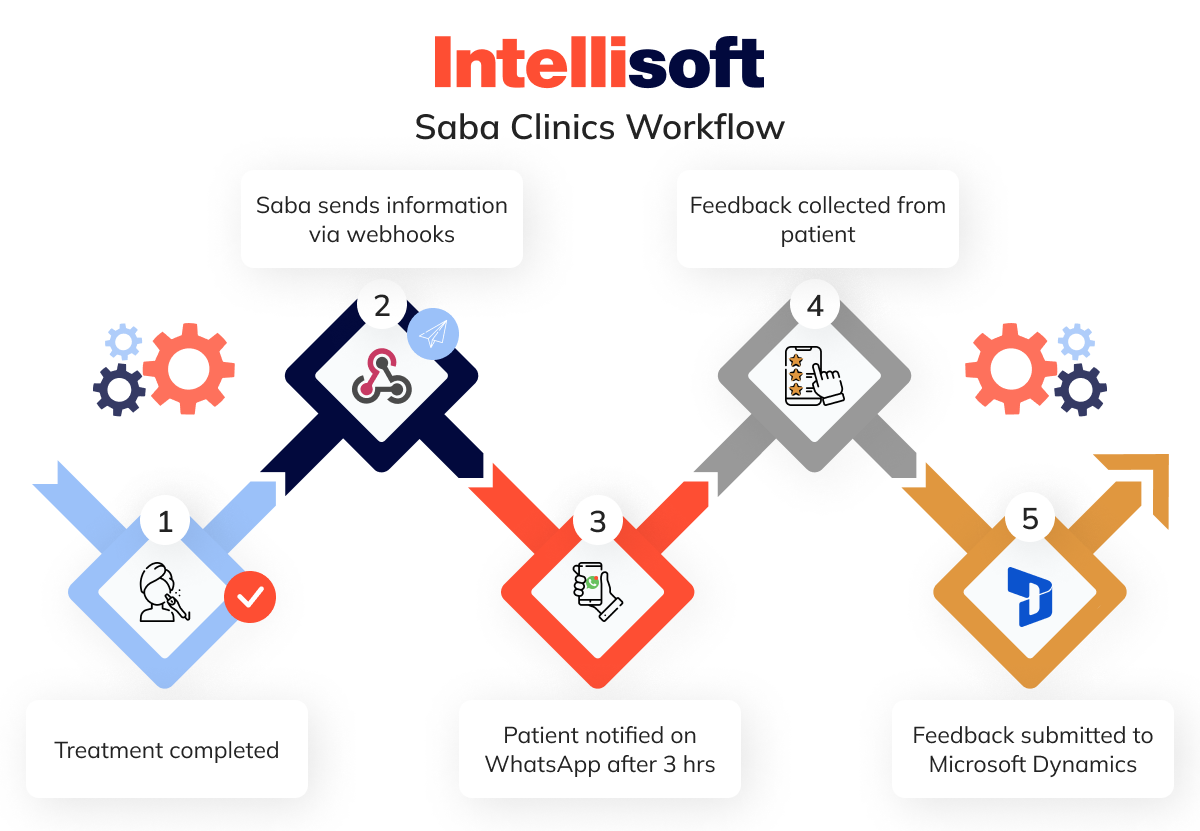
These examples illustrate the most impactful use of chatbots in healthcare. Chatbots are invaluable assets in providing quality healthcare services, from providing critical information and easing administrative burdens to enhancing patient engagement and gathering feedback.
The Critical Importance of HIPAA for Healthcare Chatbots
In modern healthcare, every aspect of technology is digital, and chatbots have become essential tools. They assist with everything from appointment scheduling to providing insurance information. As their role in handling sensitive health information expands, it becomes crucial to ensure these chatbots comply with the Health Insurance Portability and Accountability Act (HIPAA). Let’s explore why HIPAA compliance is essential for healthcare chatbots.
HIPAA Compliance as a Guard Against Misuse
Medical information is among the most sensitive data one can possess. Despite the trust in healthcare providers, the risk of data breaches remains a significant concern. Recent reports indicate that data breaches exposed tens of millions of records within a year. HIPAA compliance helps mitigate these risks by ensuring medical chatbots have robust safeguards to protect this data. This compliance prevents unauthorized access and misuse.
Building Trust Through Legal Frameworks
Under HIPAA, certain chatbots are considered “covered entities.” This legal framework establishes a trusting relationship between patients and chatbots and requires them to follow strict guidelines on handling protected health information (PHI). It also requires that any sharing of PHI with third parties involve informed consent from the patient, backed by strong encryption to secure the data.
Legal Compliance and Avoidance of Penalties
Operating healthcare chatbots in the United States without HIPAA compliance is not viable due to stringent regulations protecting PHI. Non-compliance can lead to severe penalties and legal repercussions. Surveys show that many medical organizations acknowledge room for improvement in their compliance rates. This underscores the need for all healthcare chatbots to adhere to HIPAA standards to avoid legal issues.
Enhanced Security and Control Over Personal Health Information
HIPAA empowers individuals by allowing them control over their PHI. Patients can review their chatbot interactions, correct their health records, and limit further access to their information. This level of control fosters a secure environment where patients feel more comfortable and confident in their interactions with healthcare providers. Ultimately, this security leads to better healthcare outcomes.
The necessity for HIPAA compliance in healthcare chatbots is clear. It protects patients, fosters trust, ensures legal compliance, and enhances the overall security of personal health information. Understanding the importance of this compliance is just the first step. Implementing it effectively is the next critical move for any healthcare provider using chatbot technology.
Essential HIPAA Compliance Standards for Healthcare Chatbots
To effectively integrate chatbots in healthcare industry settings, these tools must adhere to the strict standards set by the Health Insurance Portability and Accountability Act (HIPAA). Ensuring HIPAA compliance is not just about legal adherence but also about building trust and safeguarding patient information. Here are the critical requirements that healthcare chatbots must meet:
Transparency in Data Collection
Transparency is crucial in medical interactions, especially concerning sensitive patient information. Healthcare chatbots must inform patients about the type of data being collected and the purposes for which it will be used. This transparency is typically communicated through clear, accessible privacy policies that patients can understand. Enhancing transparency complies with HIPAA and increases patient trust in the digital healthcare system.
Business Associate Agreements (BAAs)
Collaboration with third-party service providers, such as cloud hosting platforms, is common when developing healthcare chatbots. To ensure HIPAA compliance, partnering with providers who demonstrate verifiable HIPAA-compliant practices is essential. Establishing a robust Business Associate Agreement (BAA) with these third parties is crucial to ensure that all involved parties uphold the required standards in protecting patient information.
Implementation of Required Safeguards
HIPAA mandates specific safeguards to protect the integrity and confidentiality of patient information. Technical Safeguards involve strong encryption protocols and strict access controls to ensure that only authorized personnel can access sensitive information. Physical Safeguards involve securing the physical locations and hardware that store patient data, preventing unauthorized physical access.
Granular Access Control
Access to Protected Health Information (PHI) must be carefully controlled and should vary based on the roles and responsibilities within the medical organization. For example, the level of access granted to a customer service representative will differ from that of a medical practitioner or administrative staff. Implementing granular access control helps minimize the risk of unauthorized data exposure.
Robust Encryption Techniques
All patient data handled by healthcare chatbots must be protected through robust encryption. PHI must be encrypted both at rest and in transit. By anonymizing and encrypting data, healthcare providers ensure it remains inaccessible to unauthorized individuals, protecting patient privacy and complying with HIPAA regulations.
Healthcare chatbots can safely and effectively contribute to the medical industry by adhering to these key HIPAA requirements. In this way, you can be sure that patient data is handled with the utmost care and security. This adherence protects healthcare providers from legal repercussions and fortifies the trust patients place in digital medical services.
Creating a Healthcare Chatbot: A Step-by-Step Guide
Developing a healthcare chatbot involves a series of strategic steps. Each step ensures the chatbot effectively meets the specific needs of healthcare providers and patients. Here’s a detailed guide on building a healthcare chatbot that complies with regulatory standards like HIPAA and enhances user engagement and operational efficiency.
Step 1. Define Your Goals
Start by clearly defining the objectives of your healthcare chatbot. What functions should it perform? Whether it’s scheduling appointments, providing medical information, or assisting with patient intake, clearly understanding its purposes will guide the development process. This step is crucial for aligning the chatbot’s capabilities with your healthcare organization’s needs.
Step 2. Choose a Development Platform
Select a chatbot development platform that matches your organization’s technical capacity, budget, and specific feature requirements, such as HIPAA compliance for handling sensitive health information. The choice of platform will significantly influence the capabilities of your chatbot, so it’s important to choose one that supports all necessary integrations and functionalities.
Step 3. Design the Conversation Flow
Map out how the chatbot will interact with users. Design a dialogue structure that includes potential user prompts, the chatbot’s responses, and branching paths to guide the conversation effectively. This step is about creating an intuitive and engaging user experience that can accurately mimic human interaction to meet the users’ needs.
Step 4. Train the Chatbot
Equip your chatbot with a comprehensive training dataset. Include diverse healthcare-specific dialogues, terminology, and user interactions. The training will help the chatbot understand and respond to queries with accuracy and relevance. The chatbot must be trained to handle a variety of interactions to ensure it can operate effectively in real-world scenarios.
Step 5. Test and Refine
Before fully launching the chatbot, conduct thorough testing to catch and correct any issues in its functionality. You must validate the conversation flow, ensure the chatbot responds correctly to queries, and refine its responses based on test outcomes. Regular iterations based on testing results can significantly enhance the chatbot’s reliability and effectiveness.
Step 6. Deploy and Monitor
Once the chatbot is fully developed and tested, it can be deployed on the chosen platform. Post-deployment, it’s essential to continuously monitor its performance to ensure it meets the intended goals. Collect and analyze user feedback to identify areas for further improvement and ensure the chatbot remains a valuable tool for healthcare providers and patients.
Following these steps will help you develop a healthcare chatbot that is functional, compliant with legal standards, and capable of transforming the patient care experience by automating tasks and providing timely information.
Selecting the Right Tools for Developing Healthcare Chatbots
Choosing the right development platforms is crucial for creating effective healthcare chatbots. These platforms provide the foundational technology for building chatbots and ensure they meet industry standards, including HIPAA compliance. Let’s explore some of the leading tools and platforms suited for developing medical chatbots.
Microsoft Azure AI Bot Service
Microsoft Azure AI Bot Service is a robust platform for building, deploying, and managing intelligent chatbots. This service offers a comprehensive suite of tools that integrate seamlessly with other Azure services, such as Azure Cognitive Services. This integration enhances chatbots with advanced AI capabilities like sentiment analysis and medical language understanding.
Azure provides pre-built bot templates tailored to the healthcare industry for medical applications, simplifying the development process. However, leveraging these sophisticated tools effectively requires certain technical expertise.
Amazon Lex
Amazon Lex is a serverless platform provided by Amazon Web Services (AWS). It simplifies chatbot construction through an easy-to-use graphical interface. Its intuitive drag-and-drop functionality allows developers to design conversational experiences visually. Lex integrates well with other AWS services, including Amazon Comprehend Medical, which offers specialized medical language processing. While Amazon Lex facilitates ease of use, developers might need additional tools and integrations for more complex chatbot functionalities.
Google Dialogflow
Google Dialogflow is renowned for its superior natural language processing (NLP) capabilities. It features a user-friendly interface that includes pre-built conversation flows and training tools, making it accessible for developers without deep coding expertise. Dialogflow integrates with Google Cloud services, such as the Google Cloud Healthcare API, ensuring that the chatbots created are HIPAA compliant. However, Dialogflow might offer limited customization options compared to other platforms, which could be a consideration for more bespoke applications of chatbots in healthcare.
Rasa Stack
For developers seeking more control over their chatbot’s development, Rasa Stack presents an open-source solution with extensive customization capabilities. Its flexible architecture allows seamless integration with various NLP tools and libraries, supported by a strong community and comprehensive documentation. While Rasa provides significant customization and control advantages, it requires more technical skill and development effort.
When choosing a platform for developing healthcare chatbots, consider factors like ease of use, specific features and functionalities, scalability, and cost. Each platform offers unique strengths and may be more suitable for different medical applications, depending on your organization’s specific needs and capabilities. Additionally, ensuring HIPAA compliance is critical in selecting a platform, as it guarantees that the chatbots will handle sensitive health information securely and legally.
Conclusion
Integrating chatbots into the healthcare sector represents a major technological advancement. These tools offer unprecedented improvements in accessibility, efficiency, and patient engagement. AI-driven chatbots are fundamentally reshaping the delivery of healthcare services. They handle routine administrative tasks like scheduling and patient inquiries and manage more complex interactions such as diagnostics and therapy support.
Chatbots are proving to be especially transformative in primary care, mental health, and specialized areas such as oncology, where they enhance service delivery and fill critical gaps in healthcare. IntelliSoft has been at the forefront of this digital healthcare revolution since 2007. Leveraging extensive experience in healthcare IT, we can develop tailored, HIPAA-compliant chatbot solutions.
These innovations strengthen healthcare institutions’ operational capacities and improve the patient experience by offering more personalized and immediate care solutions. IntelliSoft’s commitment to integrating advanced AI technologies into healthcare makes us a leader in healthcare IT innovation.
For healthcare organizations looking to harness the power of AI to improve their services and patient interactions, IntelliSoft offers customized chatbot solutions that meet the highest standards of compliance and efficiency. Contact us and start transforming your healthcare services with cutting-edge technology that improves provider and patient outcomes.
